Leeds and Liverpool Canal: Difference between revisions
No edit summary |
m →Bingley Five Rise Locks: ioe -> nhle, replaced: {{IoE|33796 → {{NHLE|1020162 |
||
| Line 24: | Line 24: | ||
[[File:BingleyFiveRiseLocks1.JPG|right|thumb|200px|Bingley Five Rise Locks]] | [[File:BingleyFiveRiseLocks1.JPG|right|thumb|200px|Bingley Five Rise Locks]] | ||
[[File:Bingley 5-rise Locks - geograph.org.uk - 387279.jpg|right|thumb|180px|The locks from above]] | [[File:Bingley 5-rise Locks - geograph.org.uk - 387279.jpg|right|thumb|180px|The locks from above]] | ||
'''Bingley Five-Rise Locks''' is a staircase lock on the Leeds and Liverpool Canal at [[Bingley]], at {{getmapecho|SE107399}}; it consists of five stages of lock gates to lift or lower a boat 59 feet. The structure is Grade I listed<ref>{{ | '''Bingley Five-Rise Locks''' is a staircase lock on the Leeds and Liverpool Canal at [[Bingley]], at {{getmapecho|SE107399}}; it consists of five stages of lock gates to lift or lower a boat 59 feet. The structure is Grade I listed<ref>{{NHLE|10201624|Bingley Five-Rise}}</ref> and is a major tourist attraction in the area; at weekends a crowd of thirty people or more may gather to watch a boat pass through the lock. | ||
In effect the five-rise consists of five locks connected together without intermediate "ponds": the lower gate of each chamber forms the upper gate of the chamber below. There are therefore five chambers, and six gates. As the Leeds Liverpool canal is a wide canal, the chambers are 14 feet wide. | In effect the five-rise consists of five locks connected together without intermediate "ponds": the lower gate of each chamber forms the upper gate of the chamber below. There are therefore five chambers, and six gates. As the Leeds Liverpool canal is a wide canal, the chambers are 14 feet wide. | ||
Latest revision as of 08:22, 19 September 2019
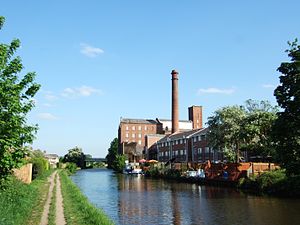
The Leeds and Liverpool Canal is a canal in Lancashire and Yorkshire, built for industrial cargoes and linking the cities of Leeds in the West Riding of Yorkshire and Liverpool in Lancashire (map). Over a distance of 127 miles, it crosses the Pennines, and includes 91 locks on the main line.
The canal has several small branches, and in the early 21st century a new link was constructed into the Liverpool docks system.
Route
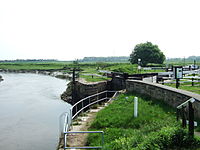
The Leeds and Liverpool Canal main line is 127 miles long and crosses the country from Liverpool in Lancashire to Leeds in Yorkshire. It has two main side-branches, the Leigh Branch and the Rufford Branch. The summit level is at 487 feet.
The canal was built with locks 60 feet long and 14 feet wide to accommodate the Yorkshire Keel barges already in use on the Rivers Aire and Humber. However, the locks on the Leigh Branch and the mainline between Wigan and Liverpool (and Rufford Branch), were extended to a length of 72 feet to accommodate the longer boats trading on the rest of the canal network following the building of the Leigh Branch.
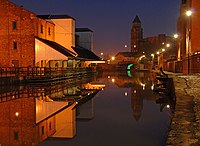
The original Liverpool terminus was at Clarke's Basin in present-day Old Hall Street.[1] This later moved to Pall Mall when land was sold to a railway company. A direct connection to the docks via Stanley Dock was built in 1846.
From Liverpool to Appley Locks, the canal runs for 27 miles without locks, across the coastal plain of western Lancashire.
The two main side-branches both connect to other waterways. The Rufford Branch links into the River Douglas and, by way of the Ribble Link and the River Ribble to the previously isolated Lancaster Canal. The Leigh Branch from Wigan leads to the Bridgewater Canal and thus to Manchester and the Midlands.
The Leeds and Liverpool Canal is said to be the longest single canal in Britain constructed by one company, but it is shorter than the Grand Union Canal which was made up of many smaller, separately dug canals joined together. The Leeds Liverpool Canal includes the southern part of the Lancaster Canal between Johnsons Hillock and Wigan Top Lock.
The canal at Aintree passes close to Aintree Racecourse and gives the name to the course's Canal Turn. The canal has one of the country's most photographed canal features: the Bingley Five Rise Locks at Bingley. Bingley Five Rise and the Burnley Embankment are two of the original Seven Wonders of the canal world chosen by Robert Aickman.
Bingley Five Rise Locks
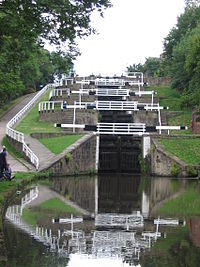
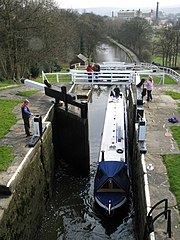
Bingley Five-Rise Locks is a staircase lock on the Leeds and Liverpool Canal at Bingley, at SE107399; it consists of five stages of lock gates to lift or lower a boat 59 feet. The structure is Grade I listed[2] and is a major tourist attraction in the area; at weekends a crowd of thirty people or more may gather to watch a boat pass through the lock.
In effect the five-rise consists of five locks connected together without intermediate "ponds": the lower gate of each chamber forms the upper gate of the chamber below. There are therefore five chambers, and six gates. As the Leeds Liverpool canal is a wide canal, the chambers are 14 feet wide.
The five-rise is the steepest flight of locks in the United Kingdom, with a gradient of about 1:5, giving a rise of 59 feet over a distance of 320 feet. The intermediate and bottom gates are the tallest in the country. Because of the complications of working a staircase lock, and because so many boaters (both first-time hirers and new owners) are inexperienced, a full-time lock keeper is employed, and the locks are padlocked out of hours.
The Locks also have an overflow waterfall at the side, which water runs down when the lock is not open. When descending boat enters each lock chanber, the water level rises slightly and the excess overflows by a channel at the side of each lock which runs into the main overflow.[3]
History
The five-rise opened on 12 March 1774 and was a major feat of engineering at the time. When the locks and therefore the canal from Gargrave to Leeds was opened in 1774 a crowd of 30,000 people turned out to celebrate. The first boat to use the locks took just 28 minutes. The first trip was described in the Leeds Intelligencer.[4] The smaller Bingley Three-Rise opened at the same time just a few hundred yards downstream.
The staircase underwent extensive restorative maintenance in 2004, and again in 2006 when the lock gates and paddles were replaced. The Five-Rise requires a great deal of maintenance and is often on British Waterways' list of winter stoppages for maintenance.
In January 2012, the locks were drained to allow the installation of new lock gates. The new gates are made of British green oak and, when installed with the balance beam, weigh over 5 tons.[5]
Liverpool link
The new £20 million Liverpool Canal Link was completed in 2009,[6] and opened on 25 March 2009.[7] It re-connects the Leeds and Liverpool Canal to Liverpool's South Docks by way of Stanley Dock,[8] allowing boats to travel past the world-famous Three Graces and into the Albert Dock.
History
Origin
In the mid-18th century the growing towns of Yorkshire including Leeds, Wakefield and Bradford, were trading increasingly. While the Aire and Calder Navigation improved links to the east for Leeds, links to the west were limited. Bradford merchants wanted to increase the supply of limestone to make lime for mortar and agriculture using coal from Bradford's collieries and to transport textiles to the Port of Liverpool. On the west coast, traders in the busy port of Liverpool wanted a cheap supply of coal for their shipping and manufacturing businesses and to tap the output from the industrial regions of Lancashire. Inspired by the effectiveness of the wholly artificial navigation, the Bridgewater Canal opened in 1759–60. A canal across the Pennines linking Liverpool and Hull (by means of the Aire and Calder Navigation) would have obvious trade benefits.
In 1766, John Longbotham was engaged to survey a route and groups were set up to promote the scheme, one in Liverpool and one in Bradford, which could not agree the route: James Brindley finally chose a northerly route, though with a branch towards Wigan, which caused some of the Lancashire backers to withdraw their support. An Act was passed in May 1770 authorising construction, and Brindley was appointed chief engineer and John Longbotham clerk of works; following Brindley's death in 1772, Longbotham carried out both roles.
Construction
A commencement ceremony was held at Halsall, north of Liverpool on 5 November 1770, and the first sod was dug by the Hon Charles Mordaunt of Halsall Hall. The first section of the canal opened from Bingley to Skipton in 1773.[9] By 1774 the canal had been completed from Skipton to Shipley, including significant engineering features such as the Bingley Five Rise Locks, Bingley Three Rise Locks and the seven-arch aqueduct over the River Aire. Also completed was the branch to Bradford. On the western side, the section from Liverpool to Newburgh was dug. By the following year the Yorkshire end had been extended to Gargrave, and by 1777 the canal had joined the Aire and Calder Navigation in Leeds.[9] On the western side it reached Wigan by 1781, replacing the earlier and unsatisfactory Douglas Navigation. By now, the subscribed funds and further borrowing had all been spent, and work stopped in 1781 with the completion of the Rufford Branch from Burscough to the River Douglas at Tarleton. The disruption to trade caused by the war in the American colonies made it impossible to continue for more than a decade.
In 1789 Robert Whitworth developed fresh proposals to vary the line of the remaining part of the canal, including a tunnel at Foulridge, lowering the proposed summit level by 40 feet, and a more southerly route in Lancashire. These proposals were authorised by a fresh Act in 1790, together with further fund-raising, and in 1791, construction of the canal finally recommenced south-westward from Gargrave,[9] heading toward Barrowford in Lancashire.
In 1794 an agreement was reached with the Manchester, Bolton and Bury Canal company to create a link near Red Moss near Horwich.[10] However, by this time the competing Rochdale Canal had begun construction and was likely to offer a more direct journey to Liverpool via Manchester and the Bridgewater Canal. The company's experiences running the two sections of the canal had also shown that coal not limestone would be its main cargo, and that there was plenty of income available from local trade between the settlements along the route. With this in mind in the same year, the route was changed again with a further Act,[9] moving closer to that proposed by Burdett and the planned canal link did not materialize. Yet more fund-raising took place, as the Foulridge Tunnel was proving difficult and expensive to dig. The new route took the canal south by way of the expanding coal mines at Burnley,[11] Accrington and Blackburn, but would require some sizable earthworks to pass the former. The completion in 1796 of the 1,640-yard Foulridge Tunnel and the flight of seven locks at Barrowford enabled the canal to open to eastern Burnley.[9] At Burnley, rather than using two sets of locks to cross the shallow Calder valley, Whitworth designed an embankment 1,350 yards long and up to 60 feet high and a tunnel of 559 yards nearby at Gannow and a sizeable cutting to allow the canal to traverse the hillside between the two. It took 5 years to complete this work, with the embankment alone costing £22,000.[12] Once completed, the canal opened to Enfield near Accrington in 1801.[9] It would be another 9 years until it reached Blackburn only 4 miles away. The long war with revolutionary and Napoleonic France increased taxes and interest rates which made it difficult for the company to borrow money, and the pace of construction inevitably slowed. The main line of the canal was completed in 1816.
Connection to the Bridgewater Canal at Leigh was made in 1820, thus giving access to Manchester and the rest of the canal network. The Bridgewater Canal, like most of Brindley's designs was for narrow boats of 72 feet length, while the Leeds and Liverpool had been designed for broad boats of 62 feet length. So that the longer narrow boats might reach Liverpool, the locks of the westerly end of the canal were extended to 72 feet in 1822.
The canal took almost 40 years to complete. In crossing the Pennines, the Leeds and Liverpool had been beaten by the Huddersfield Narrow Canal and the Rochdale Canal.
The most important cargo was always coal; over a million tons a year were delivered to Liverpool in the 1860s, with smaller amounts exported by the old Douglas Navigation. Even in Yorkshire, more coal was carried than limestone. Once the canal was fully open, receipts for carrying merchandise matched those of coal. The heavy industry along its route, together with the decision to build the canal with broad locks, ensured that (unlike the other two cross-Pennine canals) the Leeds and Liverpool competed successfully with the railways throughout the 19th century and remained open through the 20th century.
20th century
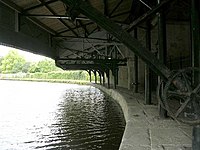
The canal suffered some damage during Second World War. It was breached by a German mine in Bootle and the headquarters at Pall Mall were damaged. The canal in West Lancashire was part of Britain's defensive plans against invasion. Along the canal there were tank traps, bunkers and blockhouses. Some buildings such as barns and pubs along the canal were fortified. There are still some remaining concrete pillboxes and brick built blockhouses.
Trade continued on the canal until as late as the 1980s. Coal was shipped to the power station in Wigan until 1972 and corn to Ainscough's Mill in Burscough until 1960. The last horse drawn barge was 'Parbold' (1960). The especially cold winters in the early 1960s were thought to have finished off commercial use of the main line of the canal, but a load of timber passed over the full length in 1965, from Liverpool to Leeds. Freight returned in 1973 (coal from Castleford to Skipton, plus various other odd cargoes,) then grain was carried between Liverpool and Manchester from 1974 for some years, plus a few loads across the summit - the last being 30 tons of herring meal on short boat 'Weaver', from Selby to Manchester (September 1978). The last intensive use of the canal for freight was carriage of effluent from Esholt to Leeds (Knostrop) between May 1978 and December 1979, and aggregate from Trent wharves to Shipley - this ceased in 1982.
The section of canal between Aintree and the Liverpool terminus was classed as “Remainder” in the review of the waterways and therefore only receives enough maintenance to keep it structurally sound.
In the 1950s and 1960s the Mersey Motor Boat Club (MMBC) did a lot of work to keep the canal open and in use. With a variety of boats, converted lifeboats and wooden boats from the Lakes, they kept boats moving on the canal after commercial use stopped. The Leeds and Liverpool Canal is one of the quietest canals for leisure boating on the network.
In the 1960s, the Pall Mall terminus basin was filled in up to Chisenhale Street Bridge (Bridge A). In the 1980s the Eldonian Village housing estate was built for the community which was disrupted by the building of the Mersey Tunnel and the demolition of the Tate and Lyle sugar refinery. This meant the canal was filled in between Chisenhale Street Bridge (Bridge A) and just north of Burlington Street Bridge (Bridge B). As part of the development a new bridge was built, Vauxhall Bridge (un-numbered) which was opened in 1994 by Cilla Black.
In August 2010, a 60-mile stretch of the canal was closed due to the low reservoirs, following the driest start to the year since records began. It was reopened the following month, although some restrictions remained.[13] Some canal boat operators temporarily relocated to other parts of the canal. As of 11 August 2010, as many as 200,000 fish were moved to different areas in the canal to prevent their death in the low-level waters.
Places on the route
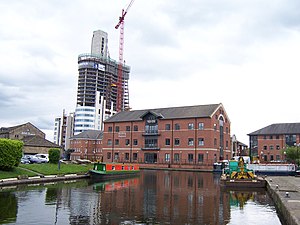
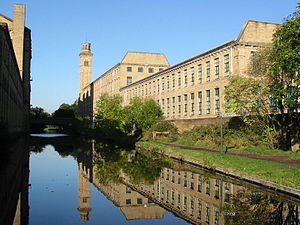
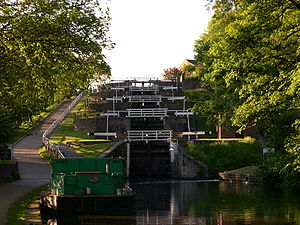
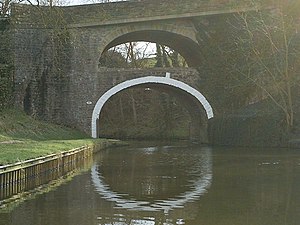
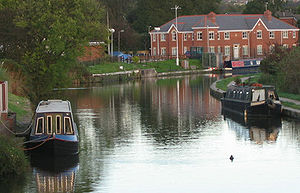
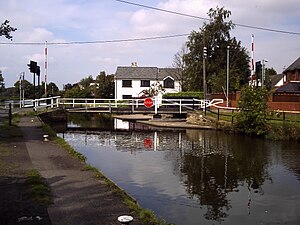
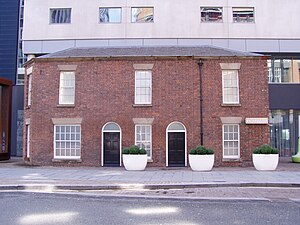
From east to west:
- Yorkshire:
- Leeds
- Granary Wharf
- Armley Pool
- Kirkstall
- Rodley
- Apperley Bridge
- Shipley
- Saltaire
- Bingley
- Keighley
- Silsden
- Kildwick
- Skipton
- Gargrave
- East Marton
- Barnoldswick
- Lancashire:
- Foulridge Tunnel
- Barrowford
- Nelson
- Burnley
- Ightenhill
- Gannow Tunnel
- Hapton
- Clayton-le-Moors - the halfway point
- Church
- Rishton
- Blackburn
- Riley Green
- Wheelton
- Johnson's Hillock
- Chorley
- Wigan - Wigan Pier
- Appley Bridge
- Parbold
- Lathom
- Rufford branch:
- Burscough
- Scarisbrick
- Halsall
- Haskayne
- Downholland Cross
- Lydiate
- Maghull
- Melling
- Aintree
- Litherland
- Bootle
- Vauxhall
- Stanley Dock Branch:
- Liverpool
Outside links
| ("Wikimedia Commons" has material about Leeds and Liverpool Canal) |
- Route map
- "200-year-old 'canal cottages' at risk in Liverpool city centre: Must we lose this historic link with Liverpool's commercial past?". The fight to save 91-93 Old Hall Street. 10 September 2001. http://www.liverpool.ndo.co.uk/oldhall. Retrieved 2006-05-03.
- Leeds & Liverpool Canal - history, virtual tour
- Photographs and History of the Leeds & Liverpool Canal
References
- ↑ "Walking and Cycling guide to the Canal". Towpath Treks. 2006. http://www.towpathtreks.co.uk/LLC/liverpool_canal.html. Retrieved 2008-06-14.
- ↑ National Heritage List 10201624: Bingley Five-Rise
- ↑ "'Dream job' lock-keeper gets MBE". Yorkshire Post (Europe Intelligence Wire). 30 December 2006. http://www.accessmylibrary.com/coms2/summary_0286-29078458_ITM. Retrieved 2012-09-25.
- ↑ "Around Bingley - Five Rise Locks and the Canal". Bingley.org.uk. http://www.bingley.org.uk/five-rise-locks.html. Retrieved 2012-09-25.
- ↑ "Rare glimpse of drained 18th Century Bingley Five Rise Locks". BBC News. 30 January 2012. http://www.bbc.co.uk/news/uk-england-leeds-16775606. Retrieved 2012-01-30.
- ↑ "Photographs of current work". Pennine Waterways. http://www.penninewaterways.co.uk/ll/liverpool-link15.htm. Retrieved 2008-06-14.
- ↑ "New canal link to boost tourism". BBC News. 25 March 2009. http://news.bbc.co.uk/1/hi/england/merseyside/7962742.stm. Retrieved 2009-03-26.
- ↑ Liverpool Link
- ↑ 9.0 9.1 9.2 9.3 9.4 9.5 "The Leeds & Liverpool Canal Society Chronology". Northern Heritage. 2006. http://www.llcs.org.uk//whitep2.htm. Retrieved 2008-06-14.
- ↑ Priestley, Joseph (1831). Historical Account of the Navigable Rivers, Canals and Railways of Great Britain. Longman, Green.
- ↑ Lancashire Historic Town Survey Programme: Burnley
- ↑ Brian Hall (1977). Burnley: A Short History. Burnley: Burnley Historical Society. pp. 40. ISBN 0-9500695-3-1.
- ↑ British Waterways announces phased reopening of Leeds & Liverpool Canal British Waterways 15 September 2010.
Books
- Clarke, Mike (1990). The Leeds and Liverpool Canal. Preston: Carnegie Press. ISBN 0-948789-40-9
